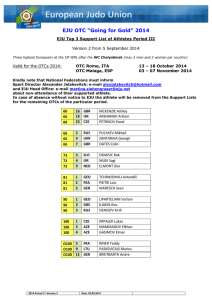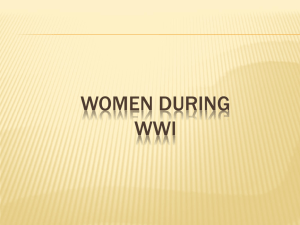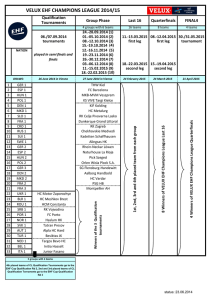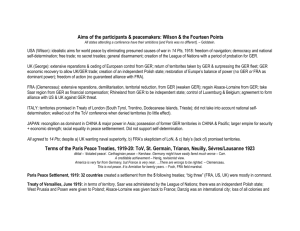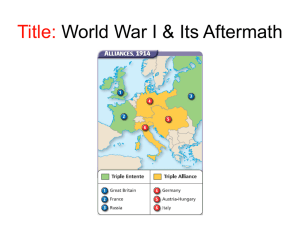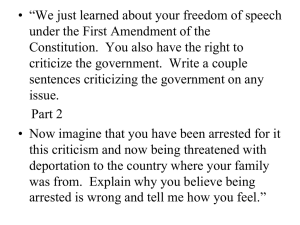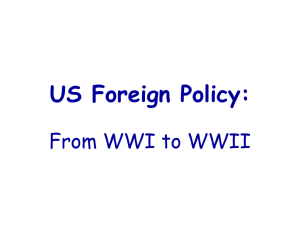File
advertisement
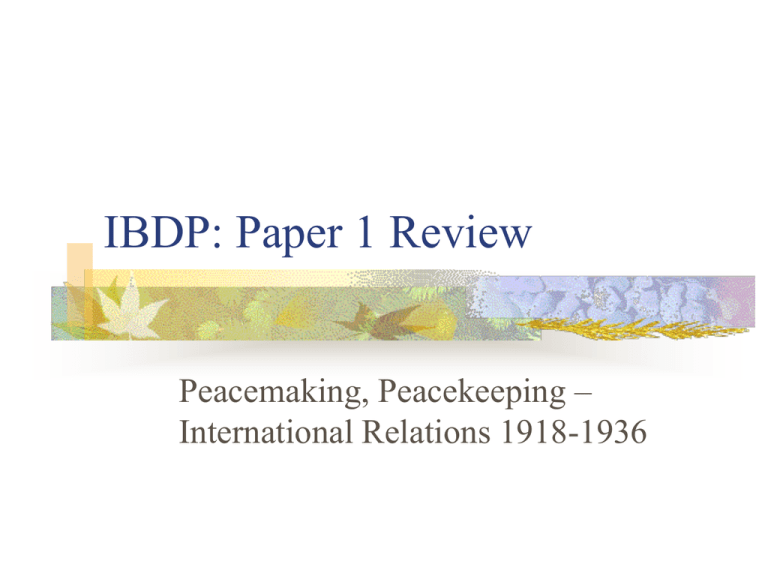
IBDP: Paper 1 Review Peacemaking, Peacekeeping – International Relations 1918-1936 Information! I need to know which AP Exams you are taking I need to know if you are going to take the Final Exam in this class Have you figured out what (A) days you will be in school in May ??? Timeline 1918 – World War I Armistice 1919 – Paris Peace Conference Treaty of Versailles (Germany) Treaty of St Germain (Austria) Treaty of Neuilly (Bulgaria) 1920 – Treaty of Trianon (Hungary) Treaty of Sevres (Turkey) 1st meeting of the League of Nations Timeline Don’t forget the Weimar Republic (1919-1933) First federal parliamentary democratic gov’t proclaimed in GER Weimar Constitution made all men & women 20+ eligible to vote Faced many internal & int’l crises Ended in 1933 w appt of Hitler as Chancellor & subsequent passing of the Enabling Act 1921-1922 – Washington Naval Conference 1922 – Mussolini becomes Prime Minister of ITA Treaty of Rapallo btw GER & RUS 1923 – Treaty of Lausanne (revised Tr of Sevres) Timeline 1924 – Dawes Plan 1925 – Locarno Treaties 1926 – GER admitted into the LoN 1928 – Kellogg-Briand Pact 1929 – Young Plan Wall Street Crash 1930 – London Conference 1931 – JAP invades Manchuria (CHI) 1932 – Geneva Disarmament Conference Timeline 1933 – Hitler is appointed Chancellor of GER JAP withdraws from the LoN GER withdraws from Disarmament Conf & LoN 1934 – The USSR admitted into the LoN 1935 – Stresa Conference Anglo-GER Naval Agreement Mussolini invades Abyssinia 1936 – GER remilitarizes the Rhineland WWI (remember causes = MAIN) Central Powers Entente Powers (Allies) GER, AUS-HGR, BUL, TUR GBR, FRA, RUS, later ITA, USA Treaty of London (1915) Secret pact signed in April between ITA & the Triple Entente which brought ITA into WWI in exchange for the promise for extensive territorial gains The Treaties ending WWI Five total treaties were signed after WWI, the most famous with GER (Treaty of Versailles) However, an additional four were signed with the other belligerents Treaty of St Germain w AUS (1919) Treaty of Trianon w HGRY (1920) Treaty of Neuilly w BUL (1919) Treaty of Sevres w TUR (1920) , later revised by the Treaty of Lausanne (1923) The Treaties ending WWI These treaties used the Treaty of Versailles w GER as a template All four defeated countries were to disarm, pay reparations, and lose territory New nations were set up REMEMBER the before & after maps of EUR! Alsace & Lorraine back to FRA Rhineland demilitarized; Saarland under League for 15 yrs Poland Czechoslovakia Free city of Danzig Yugoslavia AUS & HGRY split Serbia Wilson and the Fourteen Points The Big Three – President Wilson (USA), Premier Clemenceau (FRA), Prime Minister Lloyd George (GBR) ‘Big Four’ – addition of Prime Minister Orlando (ITA) Wilson’s Fourteen Points aimed at eliminating the causes of war: Proposed a new political & int’l world order Open diplomacy, world disarmament, economic integration League of Nations League of Nations (1920) Main aims were to promote international cooperation and to achieve international peace & security Collective security – idea that an organization of sovereign states would guarantee to take joint action if defense of one another against acts of aggression Use moral persuasion, economic sanctions and then military force (relying on member nations’ armies) 42 countries joined by July 1920, but notable exceptions were US, GER, RUS (USSR) Notable “quitters” were JAP (1933), GER (1933), ITA (1937) Wilson and the Fourteen Points Why did it fail? Proposal for free trade, end of imperialism, adoption of open diplomacy and League of Nations clashed with the realist approach of those who wanted to ensure their countries were well prepared for the possibility of another war FRA wanted to be protected from future GER aggression GBR wanted to avoid GER feelings for revenge and was worried about Bolshevism in Russia Wilson and the Fourteen Points Why did it fail? ITA wanted territory to help recover economically from the war (suffering political problems and social unrest) There was little sympathy from the Big Three for ITA partly due to their association with GER at onset of WWI and their ‘contribution’ to the war was seen as small ITA was upset that the terms of the Treaty of London would not be honored & treatment as a “lesser power” Mandates Wilson’s Point Five addressed colonialism/imperialism It acknowledged that colonialism had been a major cause in the outbreak of WWI Given that distributing the colonies of the defeated nations among the victors would have gone against Point Five, it was decided that the territories were to be put under a mandate system of int’l administration supervised by the League of Nations Mandatory nations had a responsibility for the wellbeing of those living in the mandated territories GBR, FRA, South AFR, NZLD, AUS, JAP, BELG Was the mandate system imperialism in disguise? Washington Naval Agreements (1921-22) After WWI, the US embarked on a policy of isolationism in international relations Wilson was never able to ratify the Treaty of Versailles and the Covenant of the League of Nations (US signed a separate peace w GER) Despite isolationism, Pres Harding convened the WNA to discuss naval disarmament and developments in the Far East Attended by USA, GBR, FRA, JAP, ITA, BELG, the Netherlands, POR, CHI Washington Naval Agreements (1921-22) To what extent were the Washington Naval Agreements successful? Was a first step toward application of disarmament at an international level Limited use of submarines in war & banned use of poison gas in warfare Did not prevent crises like JAP invasion of Manchuria Relative success due to small number of nations Ruhr Crisis (1923) After GER failed to pay the reparations to FR, in Dec 1922 the FR invaded the industrial area of GER called the Ruhr Valley, adjacent to the Rhineland, to ensure ‘payments in kind’ as allowed by the Treaty of Versailles GER responded with work stoppage & general labor strikes, halting industrial production The FR responded w a blockade in the area This passive resistance and shortage of coal & exports put the GER economy under serious pressure, leading to hyperinflation of GER $ Results of the Ruhr Crisis Further social & political unrest in GER Worsened economy of GER through hyperinflationary economic policy Made FR seem unreasonable and not capable of keeping EUR stable Worsened FR economy due to cost of maintaining occupation of Ruhr Valley Made clear that a review of GER reparations was necessary Dawes Plan (1924) & Young Plan (1929) The Dawes Plan presented a new schedule for the payment of reparations & discussed the withdrawal of FR troops in the Ruhr GER reparation figures were not altered, but the annual payments were reduced US loans to GER enabled them to make reparation pmts to GBR & FRA, who in turn could repay their war debts to the US The Young Plan reduced the total amount of GER reparations The Reparations Committee now could no longer impose sanctions The ‘Locarno Spring’ (1925) The Kellogg-Briand Pact (1928) The Locarno Pact was a series of treaties signed by GER, FRA, BELG, GBR, and ITA GER to accept the western border with FRA & BELG in exchange for troops withdrawal from the Rhineland FRA Foreign Minister Briand proposed a treaty to the US to outlaw war to US Secty of State Kellogg – became the Kellogg-Briand Pact and was extended to more than 60 nations Proved no more than ‘good intentions’ as, when JAP, ITA & GER broke it, nothing was done The Great Depression ended the atmosphere of international cooperation London Conference (1930) & Geneva Disarmament Conference (1932-34) The London Conference aimed at taking further steps in naval disarmament by including submarines and smaller warships The Geneva Disarmament Conference aimed at arms reduction as a whole (not just naval) Internationally, world suffering Great Depression GER was looking to either make other signatory nations reduce, or they should be able to increase, their armaments The Geneva Conference produced no results Manchurian Crisis (1931-33) Abysinnia Crisis (1935-36) These two crises really ended the ‘attempted’ era of peace during the inter-war years Manchurian Crisis ended JAP involvement in LoN The Abyssinian Crisis led to ITA to withdraw from the Stresa Front (GBR, FRA, ITA united against Hitler) and join the Rome-Berlin Axis (cooperation of foreign policies btw Hitler & Mussolini) The LoN was exposed as politically-driven and ineffective in collective security Strategies to attack the Paper 1 Questions 1a & 1b – (5 marks) Spend only 10 minutes answering! Make as many points as there are marks Question 2 – (6 marks) 15 minutes! Only 2 sources are used, so be even with your approach – evaluate evenly Intended for you to show your application and interpretation of the sources Strategies to attack the Paper 1 Question 3 – (6 marks) Again, only 15 minutes! Refer to all of O P V & L!! Intended for you to show your synthesis and evaluation of the sources Question 4 – (8 marks) Save at least 20 minutes for this! Comprehensive essay – intended for you to show your knowledge, understanding, synthesis, & evaluation of sources
